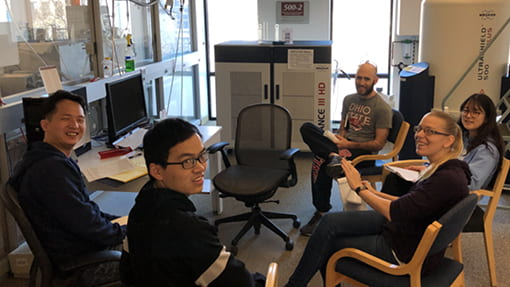Training - Level2
Level2 training is required for routine manual operation of the facility’s spectrometers. Trainees must have been certified at Level1 before proceeding to Level2. Once certified at Level2, users are allowed to operate any of the facility’s NMR instruments at room temperature; operation above or below room temperature requires a brief training on “variable temperature” (VT) operation.
Manual operation is often preferred by researchers who wish to examine their data immediately after acquisition or have special requirements like extended time, custom parameter settings, nonstandard experiments, non-ambient temperatures, etc.

Requesting Level2 Training
After a couple of weeks acquiring NMR data on automated instrumentation and successfully managing data, you are welcome to send an email to the facility manager requesting Level2 training. The manager will compile all requests and invite a small group of participants to attend a session at a proposed date and time.

What to expect
- The location (Searle or GCIS) will have been identified in the meeting invitation
- Trainee arrives in the NMR lab, joining the others in the small group (up to three trainees)
- Trainee participates in training for approximately two and half to three hours.
- Trainee must properly acquire a 1D 1H experiment independently to be certified for data acquisition.
- When a trainee has demonstrated adequate proficiency, the facility manager will (typically within 24 hours):
- Adjust account access on all the manually operated spectrometers in the facility (500-1 and 500-2 in Searle, and 500-3 in GCIS)
- Create an account on the online reservation system for the new user and provide the user its URL.
Topics Covered
Acquiring a 1D ¹H spectrum
(~60 min)
Login & CentOS orientation
- Signing in to the paper logbook
- Signing in to the workstation
- Orientation to the CentOS Linux environment
- Noting location of MNova and Topspin icons on desktop
- Starting Topspin
Sample handling
- Introduction to the “no sample in the magnet” protocol
- How to insert/eject the sample
- Familiarization with normal auditory and tactile sensations of the pneumatic ejection/insertion process
- Safety on the magnet stairs
- Orientation to magnet components seen from the stairs
Experiment setup
- Bookkeeping – creating a spectrum file for a 1D ¹H experiment
- Discussion of what parameter sets are, how to choose one, and how to ensure use of calibrated pulses (“getprosol”)
- Introduction to the essential acquisition parameters, why and how to adjust them, the acquisition parameters tab, the pulse sequence tab, and which parts of the pulse sequence file will help you get better data
- Discussion of the importance of an experiment plan – intention to perform certain experiments, especially if they involve non-1H nuclei.
- Creation of a spectrum file for a 1D ¹³C experiment in a new window
- “Locking” – what it is, why we need to perform it, and how to do it
- “Tuning” – what it is, why we need to perform it, and how to do it
- PLUS experience with demonstrator probe
- “Shimming” – what it is, why we need to perform it, and how to do it
- PLUS experience with demonstrator shimset
- Spinning – why we don’t do it though you may have heard about it
- Adjusting “lock gain” and discussion of how this is different that adjusting experiment receiver gain (“rga”)
- Reiteration of the “getprosol” procedure
- Adjusting the ¹H receiver gain – what’s going on and why we do it
- Acquiring the spectrum and briefly evaluating its quality by measuring solvent linewidth
Acquiring more experiments
(~60 min)
¹³C 1D and DEPT135
- Simple acquisition of 1D in existing window
- emphasizing that we don’t need to repeat locking, tuning, shimming
- Creating a new spectrum file for a ¹³C DEPT135 experiment, beginning acquisition
- how to process a spectrum during its acquisition
- why and how to halt or stop an acquisition before natural completion
2D Data Acquisition & Queuing Experiments
- ¹H-¹H COSY experiment
- setup in a new window
- orientation to 2D acquisition parameters and discussion of basic 2D data collection and processing
- data processing for COSY
- basic interpretation & analysis
- using the “Set Limits” tool to narrow the spectrum; discussion of its impact on acquisition time
- ¹H-¹³C HSQC experiment
- setup in new window
- orientation to heteronuclear 2D parameters
- use of “Set Limits” and the potential need to adjust the number of TD points to avoid sample heating
- refrain from acquisition
- ¹H-¹³C HMBC experiment
- setup in new window
- set limits to match those of HSQC
- Queued acquisition of HSQC and HMBC (QU command and the Spooler)
Finishing up
- Disengaging the frequency lock
- Ejecting sample, emphasizing the risk of sample breakage at this stage
- Replacing the dust cap
- Terminating Topspin
- Copying data to data transfer computer
- Logging out of the CentOS Linux environment
- Signing out on the paper log book
Certification
(~10-45 min, depending on number of trainees and their comfort levels)
- Each trainee independently acquires a 1D ¹H spectrum of their sample under supervision of the facility manager.
